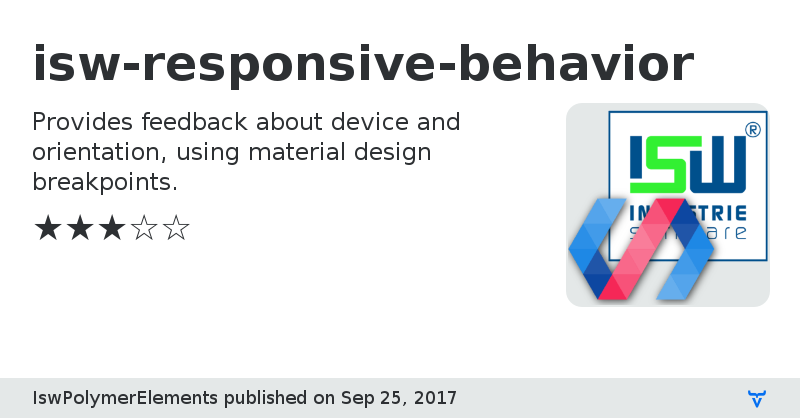isw-responsive-behavior - Vaadin Add-on Directory
Provides feedback about device and orientation, using material design breakpoints.
**[ This description is mirrored from README.md at [github.com/IswPolymerElements/isw-responsive-behavior](https://github.com//IswPolymerElements/isw-responsive-behavior/blob/1.0.5/README.md) on 2019-05-22 ]**
# \
**Deprecated! New approach with [isw-responsive](https://github.com/IswPolymerElements/isw-responsive).**
Provides feedback about device and orientation, using material design breakpoints.
https://material.io/guidelines/layout/responsive-ui.html#responsive-ui-breakpoints
### Properties
* screenWidth (Number)
* screenHeight (Number)
* device (String, "mobile", "tablet", "desktop")
* orientation (String, "portrait", "landscape")
### Add behavior
It's recommended to use it only once (e.g. in the app) and propagate it to the children (e.g. the views) via properties.
Make sure to set reflectToAttribute if attribute selectors are used in the view.
Polymer 2.0:
```javascript
class MyApp extends Polymer.mixinBehaviors([ iswResponsiveBehavior ], Polymer.Element ) {
...
}
```
Polymer 1.0:
```javascript
Polymer({
is: 'my-app',
behaviors: [ iswResponsiveBehavior ]
...
});
```
### CSS
The `device` and `orientation` properties reflect to attribute, so attribute selectors can be used.
```css
:host([device="desktop"]) .someSelector { ... }
:host([device="mobile"][orientation="landscape"]) .someSelector { ... }
```
### Elements
Some of our elements, e.g. isw-toolbar, are using `device` and `orientation` to display.
Simply bind these properties to make them responsive.
```html
...
```
### Imperative
iswResponsiveBehavior gets the onResize function called, with Polymer 2.0 classes it can be used like a lifecycle function.
```javascript
onResize() {
super.onResize();
switch( this.device ) {
case 'desktop':
// Desktop.
break;
case 'tablet':
// Tablet.
break;
default:
// Mobile.
}
}
```
Issue trackerLicense
View on GitHub
Online Demo
GitHub Homepage
Documentation
isw-responsive-behavior version 1.0.0
### Dependencies
Polymer/polymer#^2.0.0-rc.2
isw-responsive-behavior version 1.0.1
### Dependencies
Polymer/polymer#^2.0.0-rc.2
isw-responsive-behavior version 1.0.2
### Dependencies
Polymer/polymer#^2.0.0-rc.2
isw-responsive-behavior version 1.0.3
### Dependencies
Polymer/polymer#^2.0.0
isw-responsive-behavior version 1.0.4
### Dependencies
Polymer/polymer#^2.0.0
isw-responsive-behavior version 1.0.5
### Dependencies
Polymer/polymer#^2.0.0